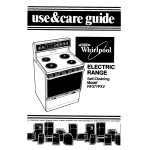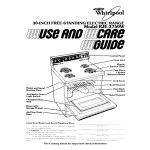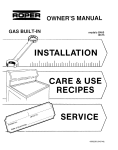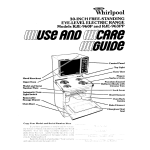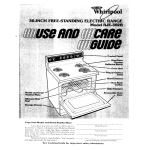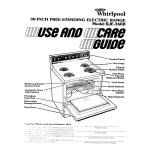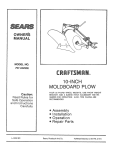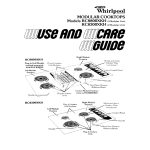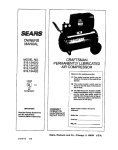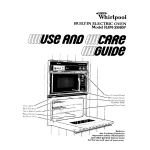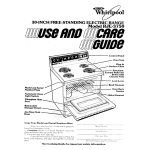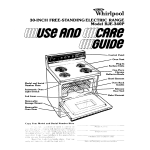Download Whirlpool RJE-953PP User's Manual
Transcript
SO-INCHFREE-STANDING EYE-LEVELELECTRICRANGEModeiRJE-953PP /y Oven Vent ne-Piece Chrome Reflector Bowls Broil Hood Element Knockout Model and Serial Number Plate Bake Element Automatic Oven I Digital Clock 1 Minute Timer A Stan Time Knob Start Knob \ . y Time Upper Oven Signal Light Upper Oven Temperature Upper Oven Selector Lower Oven Signal Lower Oven Temperature Lower Oven Selector Control Knob Control Knob Knob Light \ ’ . / Top Light Knob Switch Surface Unit Surface Unit Signal Oven Light Control Switch Knobs Lights Table of Contents ...... .............. BEFORE USING YOUR RANGE ........ ..... USING THE SURFACE UNIT CONTROLS USING THE OVEN CONTROLS ...................... .................. l Baking.. .................. .. . Broiling ............................ l Variable Broil Feature l Resetting the Oven Ternperature‘Contr’ol.Knob ::: :: SETTING THE CLOCK TO THE CORRECT TIME OF DAY USING THE MINUTE TIMER ........... USING THE AUTOMATIC MEALTIMER”’ CLOCK .... OVENRACKPOSITIONS .... ...................... USING THE OVEN LIGHTS ........ .:::: USINGTHETOPLIGHT ................... .............. THEOVENVENT ............ THE OPTIONAL ROTISSERIE .................... ..... YOUR CONTINUOUS CLEANING OVENS ...... ... CLEANING AND CARING FOR YOUR RANGE : : .. . Removing and Replacing Control Knobs .......... l Cleaning Under the Cooktop ..................... l Removing the Lower Oven Door .................... l Removing the Storage Drawer ...................... ... .......... l Cleaning Chart ......... ...... .. IF YOU NEED SERVICE OR HELP ......... 1. Before You Call for Service ....................... 2 If You Need Service 3. IfYouHaveaProblem. .:“‘:::::::I::::::::“: Before using your Page 3 11 12 13 range IMPORTANT This is the only fine print you‘ll find in this booklet. Please read it to be sure you use your range as it was meant to be used. We build appliances to last. but we can‘t control how they are used. Before using it. you are personally responsible for making sure that it l is properly installed and leveled on a floor that will hold the weight, and in a well-ventilated room. l is connected only to the right kind of outlet with the right electric supply and grounding. l is used only for Jobs expected of home ranges. l is out of the weather. l is properly maintained. l is not used by children or others who may not understand how it should be used. 3 Using the surface unit controls The Surface Unit Control Knobs must be pushed in before turning them. This helps avoid turning them on accidentally when wiping off the Control Panel. And it helps keep small children from turning them on. You must push in on them.. the window. PUSH IN and turn until the setting shows in the window. .then turn until the setting you want shows in The four Surface Unit Controls and Signal Lights are arranged in the same order as the Surface Units. For example, to turn on the right front Surface Unit [ . I> push in and turn the lower right Surface Unit Control [ ;I. The lower right Signal Light [ i ] will glow. The knob may be set anywhere between “HI” and “OFF.” As you use your surface units. you WIII get used to the settings that match your pots. pans and favorite foods the best. As a guide, the setting should cook at about the following heats. HI -To start most foods cooking. To bring water to a boil. MED-HI -To hold a rapid boil. to fry pancakes or chicken. MED - To make gravy, puddings and icings: to cook large quantities of vegetables. MED-LO -To keep food cooking after starting it at a higher setting. LO -To keep food warm until ready to serve. You can set the heat higher or lower within the “LO“ range to help keep food at the temperature you want The Signal Light will glow whenever a Surface sure this light is off when you have finished cooking. Using the Oven Unit is on. Be Controls To bake, broil or time bake in the upper oven. set the Upper Oven Selector and the Upper Oven Temperature Control Knob. To bake. broil or time bake in the lower oven. set the Lower Oven Selector and the Lower Oven Temperature Control Knob Baking: To bake, Selector turn the Oven Knob to BAKE. First-Follow the directions on page X for “Positioning Oven Racks.” Second-Turll the Oven Selector Knob to “BAKE.” Third-Turn the Oven Temperature Control Knob to the baking temperature you want The Oven Signal Light will glow while the oven is heating. When this light goes off, the oven has heated to the temperature you set. Fourth-PIact, food in oven. The heating elements turn off and on during baking to keep the oven at the temperature you set The Oven Signal Light will glow when the heating elements are on. Fifth-When the baking ISdone. turn both the Oven Temperature and Oven Selector Kllobs to “OFF .’ Broiling: First-Follow the directions below for placlng the meat at the right distance from the Broil Element. Second-Tllrn the Oven Selector to “BROIL.” Third-Turn the Oven Temperature Control Knob to “BROIL” or turn it to a lower temperature (see “Variable Broil Feature.” on page 6 ). Fourth-Put the broiler pan on the oven rack. Fifth-Keep the oven door open about four inches (10 cm). There is a stop in the hinges to hold it there. The Oven Signal Light will glow while the broil element is on Sixth-When you are through. turn both the Oven Temperature Contro! and the Oven Selector Knobs to “OFF” To broil, Selector BROIL. turn the Oven Knob to The following chart suggests broiling times and oven-rack positions for different kinds of meats when the Oven Selector Knob is set to BROIL. Food Description Inches (cm) from top of food to Broil Element Approximate Minutes 1st side 2nd side 1’ 12.5 cm) 1’ i2 5 cm) 1’ 12 5 cm) 3” (S cm) 3” (8 cm) 3” (X cm) 7-9 9-11 11-13 3-5 4-7 5-7 1!2 4” 4” 4” 3” 1315 17-19 19-21 6-S 6-8 8-10 14-16 4-s 3” (X cm) 6-t; 4-5 :3” iX cm) 3” (8 cm) 4” -5” (lo-13 cm) 6-S 6 4-5 4 15 10 ,‘, m‘)” ( 111-23 cm) 3” (H cm) 3” (X cm) 25-X 11-16 7-s 10-12 9-14 5-7 (4Crni 1’1” (4 cm) l’~“(4cml Id’ (1 cm1 Upper Oven ALWAYS broil with the door open about 4 inches (10 cm). FlSh Lli t’l Lower Oven 1’ 2 5 cm) I “. 1” (l-2 5cm) I.1 Ilcml i4”~ 1” 12-2 5 cm) 2m.1lb l,l 1 cikg) cut in hali ~l.llOlt’ flll?ts I , i,” 11~2cm) -5” (10-13 cm) -5” ilOcm) -5” (10-13 cm) (8 cm) 3” (S cm) 4” -5” (10-13 cm) 13 6-7 3 4-5 Variable ( Remove the locking 1 screw; NOTICE position of notches. Broil Feature: You might want to broil some foods slower than others. Broiling can be slowed down by setting a lower temperature on the Oven Temperature Control Knob instead of “BROIL.” Using a lower temperature will cause the broil element to turn on and off during the broiling so that the food broils more slowly. When the Oven Temperature Control Knob is on “BROIL.” the Broil Element heats all the time. Set the temperature lower and it heats some of the time. The lower the temperature setting. the shorter are the periods of heating. NOTE: The Oven Selector must be in the “BROIL” position in order for the Broil Element to heat. Resetting Lower: move black part toward “LO.” One notch equals about 10°F (5°C). Setting Higher: move black part toward “HI.” One notch equals about 10°F (S’C). the Oven Temperature Control Knob: Does your new oven seem hotter or colder than your old oven? The temperatures in older ovens often shift very gradually. getting hotter or colder without the user really noticing the change. Your new oven is properly adjusted to provide accurate temperatures, but when compared to your old range. the new design may give you different baking results. If you think that the temperature setting on your range needs to be hotter or colder, you can adjust the Temperature Control Knob by yourself. To adjust the setting, first pull the Oven Temperature Control Knob straight off. On the back. just across from the locking screw, are a row of notches on the black part of the knob and one tooth on the chrome part. To set your oven about lO”F(5”C) cooler. remove the locking screw and move the row of notches one notch closer-to “LO.” To set your oven about lO”F(5’C) warmer, move the row of notches one notch closer to “HI.” Each notch equals about lO”F(5”C). Replace the locking screw. the clock to the correct time of day 1. Push in the Minute Timer Knob and turn it clockwise until the digits show the correct time of day. 2. The Minute Timer dial will turn as you set the clock. When clock is set. let the knob pop out. Then. while it is out. turn the Minute Timer hand counter-clockwise to “OFF.” If you push in on the knob when setting the Minute Timer. you will change the setting of the clock Usinq the Minute Timer Turn the knob until the minutes you want to time show in the When the time you set is up. a buzzer will sound. Turn the dial to “OFF” to stop the buzzer. The Minute Timer does not start or stop cooking. It only buzzes when the time you set is up. It can be used to time almost any cooking operation. It can even remind you of other things (like when to add softener to the washer). For the most accurate timing. turn the knob past the time you want. Then turn it back to the setting. window. Minute 6 Timer Usinn the automatic MEALTIMER” clock The automatic feature of the MEALTIMER” Clock lets you be away from home when the oven starts. or when it stops. It will turn on and off automatically, or lust turn off automatically. Either oven can be used. Let’s say you have a roast that will take four hours to cook. Dinner IS supposed to be at G:OO.but you have an appointment at 1:30 and you know you won’t get home until at least 4:OO When do you have time to put in the roast” With the Autornatlc MEALTIMER’ Clock, it‘s easy. Just before you leave for your appointment. put the roast in the oven, set the start time for 2 00 and the stop time for 6:00 (four hours). Set the Upper or Lower Oven Selector to “TIMED” and set the corresponding Oven Temperature Control Knob for the temperature you want. Then leave. The oven will start at 2.00. bake for four hours at the selected temperature. and shut off at 6 00 'Tmk To start and stop your oven automatically: 1. Be sure the clock is set to the right time of day. (The start and stop time hands will also show the correct time.) 2. Place the food in the oven. 3. Push in and turn the Start Time Knob clockwise to the time you want the oven to start. 4. Push in and turn the Stop Time Knob clockwise to the time you want the oven to stop. 5. Turn the Oven Temperature Control Knob to the temperature you want to use to cook the food. 6. Set the “TIMED.” Oven Selector to When cooking is finished, turn both the Oven Selector and the Oven Temperature Control Knobs to “OFF” If you want to stop the oven before it stops automatically, turn the Temperature and Selector Knobs to “OFF.” Remove food from the oven. You don’t have to do anything with the Stop Time Knob. When you want the oven to start now, but stop automatically: 1. Be sure the clock and the start and stop time hands show the right time of day. 2. Put the food in the oven 3. Push in and turn the Stop Time Knob to the time you want the oven to stop cooking. 4. Turn either Oven Selector to ‘.TIMED” and the corresponding Oven Temperature Control to the temperature setting you want. 5 When cooking is finlshed. turn the Oven Selector and Temperature Control Knobs tc: “OFF“ Oven rack positions Your upper oven and lowel- oven each have bkro racks Always put the racks where you [<rant them to be before you turn on an oven. To remove a rack. take hold of it on the front edge and pull it out until it stops Then lift up the front edge and pull again. It will slide past the stops, out of the glidc,s and out of the oven. To put it back. fit the back corners into the guides at each side of the oven and slide it III. keeping the front tilted up until the rack passes the stops in the rack guides. For: Place Rack: Baking On the second or third rack guide from the top so food is in the center of the oven. So food is about the distance from the broil element suggested in the brolllng timetable under “Using the Oven Controls ” On the bottom rack guides. Broiling To remove rack, pull forward until rack stops, lift front and pull. Roasting LARGE cut\ of meat Roasting SMALLER cuts of meat So food is In the cpnter of the oven. When baking, always leave at least 1% to 2 inches (4-5 cm) of air space between the sides of a pan and other pans and the oven wall for air circulation. 0 For best results. get addItIona information on placing pans. cookie sheets and other utensils from the “Cooking Guide.” 00 Using the oven lights Both the Upper and Lower Oven Lights will come on when the Lower Oven Door is opened. To turn on the oven lights without opening the door, push the Oven Light Switch. Push it again to turn the lights off. 0 @ Replace with a 40-watt APPLIANCE bulb. To replace oven light bulbs: 1. Turn off the electrical power at the main power supply. 2. Remove the light bulb from the socket. 13. Replace the bulb with a 40watt appliance bulb (designed to stand up to oven hc>nt) available at most grocery. variety and hardware stores Using the top light The fluorescent top light is under the upper oven. The Top Light Switch is on the control panel. Push it in and hold it for a second or two to turn on the top light Push it in again to shut it off. remove screws To replace top light, remove three outer screws. To replace the top light tube: 1. .Turn off theelectrical power at the main power supply. 2. Remove the screw at each end and the one toward the front. Remove the metal trim. 3. Lower the glass cover with both hands and pull it toward you until it comes away. NOTE: The glass cover is heavy. Hold on! 4. Turn the tube toward you until it slides out of the end caps 5. Replace it with any 20-watt cool-white fluorescent tube. turning it away from you the glass cover with both hands, sliding glass into the rear trim until it snaps into place at the back. 7. [Hold the glass up and replace the metal trim and screws. 6. Replace The oven vent There is an oven vent under the right rear surface element. When the oven is on. heated air will escape through it. A vent is needed for air circulation in the oven during baking. You can cook on this surface unit while the oven IS on A warm pan of food will stay warm on this unit while the oven is on. It may be warm enough to melt butter. too. Do not try to save heat or energy by blocking the vent. Poor baking can result. Plastic utensils may melt if they are over the vent while the oven is on. The optional rotisserie If you would like a rotisserie with your oven. you can order a kit from your dealer Easy installation instructions come with the kit. 9 Your continuous How a Continuous Liquids spread on rough surfaces; bead up on smooth surfaces. cleaning Cleaning ovens Oven Works: A standard oven has walls with a smooth porcelain enamel finish. A Continuous Cleaning Oven also has a porcelain enamel finish with one important difference: instead of being smooth, like glass. the walls of a Continuous Cleaning Oven are a little rougher.. like the surface of a brick. A fat spatter will form a solid drop on a smooth surface But on the rougher surface in a Continuous Cleaning Oven. a fat spatter spreads out to a very thin layer. Think of the difference between a drop of water on a piece of waxed paper and one on a paper towel. The water on the waxed paper will stay together in a bead. The water on the rougher paper towel will spread out over a larger area This is about what happens to a fat spatter in a Continuous Cleaning Oven. Instead of a bead of fat that turns into black charred material when heated. the fat spatter spreads out. Then, when the oven is used for baking and roasting. the fat gradually burns away. The rougher surface returns to a presentably clean condition. This is a gradual process: it does not happen right away. The walls continuously clean themselves, but only when the oven is set for the medium to high temperatures during baking or roasting. The oven can be presentably clean iwith little or no hand cleaning.. depending on how It is used. The continuous cleaning process does not apply to uncoated parts like the lower oven window. oven racks and the inslde of the upper oven door. Soils that are removed.. and those that are not: Fat spatters from meat roasting. oven frying and broiling are the usual oven soils. The5 can be continuously cleaned away most of the time Spillovers from pies and casseroles. sugars and starches. and other soils that fall to the bottom of the oven are very hard to remove. That is why heavy-duty aluminum foil is placed on the bottom of the oven. It helps catch these spillovers and the foil can be replaced when necessary. Caring for your Continuous Cleaning Ovens: Follow trusted recipes for baking. roasting and broiling. They will give time. temperature and pan recommendations to help avoid smoke. spatter and spillovers. 2. Keep heavyduty aluminum foil on the bottom of the ovens. If foil is not used, and something stain. Use aluminum easy cleaning. foil for spills over, it may leave a permanent c‘3 The oven racks should be kept clean with hot. sudsy water. Use soapy steel-wool pad or plastic scouring pad to remove stubborn spots Rinse well and dry with a soft cloth 4. The lower oven window and the upper oven door should also be kept clean with hot. sudsy water. Do not use a soapy steel-wool pad on the window or door. Rinse well and dry with a soft cloth. . Keplacing aluminum foil on the oven bottom: You can use the heavyduty l&inch (45 cm) aluminum foil found in most grocery store5 Or you can order an aluminum foil kit (Part Number 2414:-O) from your WhIrlpool Dealer. 1. When cutting thtl foil, make sure it is long enough to cover the bottom with enough left over to start up both sides. 2. Make sure the bake element is cool. Lift it far enough to raise Its feet from the bottom of the oven. (You may have to remove an oven rack I 3. Slide the foil sheet under the bake element Make sure it is centered and long enough to start up the sides. 4. When you put the bake element back down. make sure all the feet rest solidly on the foil and that the foil is smoothed out across the bottom of the oven. If the feet on the element are not solidly on the foil. the oven may not bake properly. If results aren’t what you expect: Remember. the ovens keep themselves presentably clean at normal baking temperatures. If you do very little baking. but a lot of broiling, you may see fat spatters on the oven walls and door. This is because broiling will add new spatters faster than old ones can be burned off. In some cases. you may want to clean the oven by hand. Hand-cleaning the Continuous Cleaning Ovens: 1. Wash with hot. soapy water and rinse well. 2. Use a soapy steel wool pad or plastic scouring pad for more stubborn spots. 3. Do not use commercial oven cleaners. These cleaners may collect in the rough porcelain enamel finish. The fumes from commercial oven cleaner trapped in the porcelain enamel surface may be harmful. 4. Use hot. sudsy water on the upper oven door. Rinse well NOTE: The lower cooler. This also get as hot as the of the door may for broiling or at The door doesn’t have the Cleaning and oven door is ventilated to help keep the outside means that the inside of the oven door does not oven walls. Because of this, some hand-cleaning be needed.. . especially if the oven is used mostly low baking temperatures. lining on the upper oven is chrome-plated. It special porcelain enamel finish. caring for your range Your range is designed to be easy to clean. You will usually wipe off spills and spatters u’hen they happen. but you will sometimes want to clean under and behind the control knobs and surface units. This section will tell you how to remove those. and what to use when cleaning. Removing 1 2. 3. 4. 5. and replacing surface unit control knobs: Be sure the control knobs are set to “OFF” Pull straight out on the black knobs. If the control has a chrome trim ring. pull it straight out. Wash the knobs (and trim rings) in warm. sudsy water. Replace the trim rings first. If the control spring was removed, it back exactly as shown on the left...small put end first. 6. Hold the black knob so it points to “OFF.” Push it straight back on. Pull knob and trim ring straight out. Remember how the spring goes. Removing 1. 2. 3. 4. and replacing oven control knobs: Be sure the knobs are set to “OFF” Pull each knob straight off. Wash the knobs in warm.sudsy water. The knobs are not interchangeable. Make sure you put the adjustable Oven Temperature Control Knob on the right place, and the nonadjustable Oven Selector Knob on the other. 11 1,j Removing Terminal surface wash surface mal use. To remove surface unit, lift and pull straight out. units and reflector bowls: 1. First. be sure the Surface Unit Controls are all “OFF“ and that the surface units ari’ cool. 2. See where the surface units plug into the range’? Lift each surface unit about an Inch (2.5 cm) at the edge away from the plug-in (receptacle). Pull the unit straight away from the plug-in. Do not units; they will burn themselves clean during nor- 3. Lift out the reflector bowls. Hold surface unit level when replacing. Replacing reflector bowls and surface units: 1. Be sure the surface unit controls are on “OFF” 2. Put the reflector bowls back into their places. Make sure you can see the plug-ins (receptacles) for the surface units through the square hole in the side of each bowl 3. Hold the surfac-e unit level with the prongs (terminals) pointing at the plug-in 4. With the prong5 started In the plug-111.start pushing in on the surface unit At the same time. lift a little on the side of the surface unit that‘s by the plug-tn 5 Make sure the kurface-unit prongs are pushed into the plug-in as far as they will g” The surface unit will fit into the reflector bowl and be level when everything has been done right. Removing and replacing upper oven rack guides Lift the front of the rack guide. Swing it away from the oven wall far enough for the tab to get clear of the slot In the oven wall. Pull the guide straight out of the oven To put it back. fit the end of the rack guide into the hive holes in the back wall of the oven. Line up the tab on the guide with the slot !n the side wall. Push It in and push down a little to lock it in place Cleaning under the cooktop: To clean the area under the cooktop. lift the front of the cooktop at he center Raise the \wing-up rod to hold it. (Be sure the tip of the rod is in the notch in the cooktop.) Use warm soapy water and a sponge or cloth. Scouring powders or- any other abrasive cleaner may harm porcelain enamel finishes and can scratch chrome. Be careful not to raise the cooktop so high that it touches the upper oven. And don’t drop it. Dropping the cooktop can chip or crack a hard porcelain finish. or damage srde panels and surface units. Prop up the top with support rod. 12 Removing the lower oven door: Removing the oven door may make it easier to clean the oven. To remove the door. first open it to the first stop (about 4 Inches or 10 cm). Take hold of both sides of the door near the top; then lift it at the same 1 angle it is in. 1 a Pull straight with angle of part-open the door. With the door off. you will notice how the ends of the hinges slide into slots at the bottom corners of the door. To put the door back on. fit both bottom corners of the door over the ends of the hinges. Push the door down evenly. 50 neither corner gets ahead of the other When it reaches the bottorn. vou can close the door. A safety latch WIII hold the door open until it 15on correctly. Removing the storage drawer: The drawer below your oven is meant to store pots and pans. Never keep anything Push down evenly. Pull to stop. Lift; again. pull PART WHAT Outside of appliance Soft cioth. warm soapy water TO USE Nylon or plastic scounng pad for stubborn spots Surface units in there that will burn or melt. You may ulant to remove the drawer for cleaning under the range. Pull it straight out unt11It stops. Lift the front and pull some more to get it over the stop. Now Jrde it out until it stops again. Lift the drawer away from the range until it slips out of the guides. To put it back fit the side rails at the back of the drawer into both guides 1111 the range Push it closed uihile lofting the front to get past the stops No cleaning required HOW l l Warm, sudsy water and bristle brush Chrome reflector bowls Automatic drshwasher or warm. soapy water or plastrc scrubbing pad Wipe off regularly when range is cool. 110 not allow food containing acids (such as \‘rnegar. tomato. lemon juice or milk) to remain on surface. Acids will remove the glossy finish. l I )$I not use abrasive or harsh cleansers. l ,ipatters or spills wrll burn off. l Control knobs and chrome rims TO CLEAN lLipe off excessive spills with damp cloth when \llrface unit is cold. l I Jo not Immerse in water. l M;ash. rinse and dry well l r)o nd soak. l Clear1 frequently l Mash wrth other cooking utensils. l f 11I not use harsh abrasives. 13 PART WHAT TO USE HOW TO CLEAN l Wash with other cooking utensils. Warm. soapy water l Wash. rinse and dry with soft cloth Commercial glass cleaner l Follow directions with cleaner. Oven racks Warm. soapy water or soapy steel wool pads l Upper oven rack guides Warm. soapy water or plastic scrubbtng pad Warm, soapy water or soapy Aluminum broiler pan and steel wool pads grid Control panel Oven door glass Warm. soapy water or plastic scrubbing pad Commercial glass cleaner Continuous Cleaning Oven Warm. soapy water or soapy scrubbing pad Heavy-duty aluminum foil available at grocery stores or order Part No. 241430 from your Whirlpool dealer or your TECH-CARE” service representative Wash, rrnse and dry. Use steel wool pads for stubborn areas. l Wash. rinse and dry well. l Do not use harsh abrasives. l l l l l Make certain oven is cool. Wash. rinse and dry well \vith soft cloth. Follow directions provided with cleaner. Clean stubborn spots or stains. Rinse well with clean water. Place strip of aluminum forI on bottom of oven to catch sptllovers. Do not use commercial oven cleaners. Most fat spatters on the Contenuous Cleaning porcelain enamel interror surface gradually reduce to a presentably clean condition during normal baking or roasting operations Upper oven door liner Warm soapy water or plastic scrubbing pad l l 14 Make certain oven door is cool. Wash. rinse and dry well with soft cloth. Do not use harsh abrasives IF YOU NEED SERVICE THESE THREE STEPS: OR HELP, WE SUGGEST 1. Before you call for service” YOU FOLLOW : If your range does not seem to be operating properly. check the following before calling for service If nothing l l operates: Is the range plugged into an operating outlet or wired into a live circuit with the proper voltage’? (See Installation Instructions.) Have you checked the maln fuse or circuit-breaker box? If an oven will not operate: l l Is the proper Ovtln Selector Knob (upper or lower) turned to a setting (BAKE (II- BROIL.. but not TIMED)? Is the pl-oper Oven Temperature Control Knob (upper or lower) turned tc-1<qtemperature setting? If surface l l l units will not operate: Have you checked the main fuse or circuit-breaker box? Are surface units plugged In all the way? Do the control knobs turn? If surface-unit l l If soil is visible l l l Control Knob or Knobs will not turn: Is the spnng put In correctly. as shown on page 11 in the “Cleaning and Caring for your Range” SectIon? Did you push in before trying to turn’) on Continuous Cleaning Oven finish: The special finish is designed to gradually reduce oven soil during normal baking or roasting. It is not designed to keep your oven spotless only presentably clean. If you broil often. you may see oven soil. The door IS cooler than oven walls. Soil will be more visible on the door than other areas in the oven. See page 10: “Your Continuous Cleaning Oven If cooking results aren’t what you expect: Is the range level’ l Are you using pans recommended in the Cooking Guide? l If baking. have you allowed 1 lo to 2 Inches (4-5 cm) on all sides of the pans for air circulation? l Does the oven temperature seem too low or too high? See page 6, “ResettIny Your Oven Temperature Control Knob.” l Have you preheated the oven as the recipe calls for? l Are the pans the size called for in the recipe? l Are you followlny a tested recipe from a reliable source? l Do the cooking utensils have smooth, flat bottoms? l Do the cooking utensils fit the surface unit being used? See the Cooking Guide for more information on cooking problems and ho\.clto solve them l 2. If you need service. : If your WHIRI.F’OOL appliance ever needs service anywhere in the Unltt>d States. help IS lust a phone call away... to your nearest Whlrlpc)c>l franctlwd TECH-CARE- service representative. 1L’hIrlpr,(~)l m(l~n~a~ns a nntlonwide network of franchised TECHC‘ARE ber~(‘t~ iompanles to fulfill your warranty and provide aftericnrranti >t’r\‘lc‘c a11dmatntenance to keep your WHIRLPOOL appliance III peak ~i)lliiltl~,n 15 jbu’ll find yc)ur nearest TECH-CARE service company listed in your local telephontj book Yellow Pages under Washers/Dryers-Repairany or Servlclng Should you not find a listing, dial free, the Whirlpool COOL-LINE’ service When calling from: Michigan Alaska & Hawaii assistance telephone number (800) 253-1301. (800) 632-2243 (800) 253-1121 If you move... To makr hurl’ that your appliance IScorrectly installed and to insure its conr~nut~d satls?(lctc)ry operation. please telephone your nearest TECl~+CARE” hcr\~ce company for installation or to get the name of a cjuallflcd Installt’r (lnstallatlon cost will. of course, be paid by you.) Helpful hints.. 1’0~1can tltlll) your TECH-CARE service representative give you :dstt’t- \tJrL’lctl ofyou 111c1ude the model and serial number of your appliance i< hen requestlny XV L’IC~’Also. retain your sales slip and warranty to verify ~‘(~)ulwarrdntv st<lfuRemember.. \r’our I‘ECH (‘AKF. stlrvlcc’ representative is specially tralned in the expert r+alrlny ‘111~: >ervIclng of your WHIRLPOOL appliances He can help ~C>LI m;lllltalll thr quality orly~nally built Into your WHIRLPOOL ,~ppl~al~cc SO ikilL not take the time. now. to look up his telephone number and lot II dc)i~n 111the ~pdc~lprovided on the cover 3. If you have a problem : Call Wh~rlpo~~lCorporation 111Benton Harbor at the COOL-LINE ~~~rvIc~~ ilbs1stancIl t~‘:~phont~ number (see Step 2) or write Mr Stqhrrl E Lll,t( III, L’ICC Pleslcient Whlripool COI~OI~II,~111 Adm;nlstratli,tl (‘~JII!~‘I 2!)0(1 L! 5 Ii,< NClrtl Benton t Ic9rbor. MI< !II~<I~ J~)O22 It vou mr15t ~.all ot wrlttl. please provldc. your name. address. tel~phol~~~~lumll~~r t~‘p~ ot dppl~ance. brand, model. serial number. date of purcllas~l. tilt, dtl,ilx’\ name. and a complete description of the probISneclded in order to better respond to your request lem Ttrls Inf~mmtlc~rl tor nssritallc‘ta
















